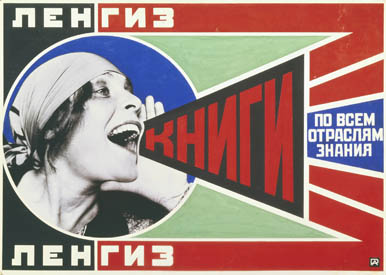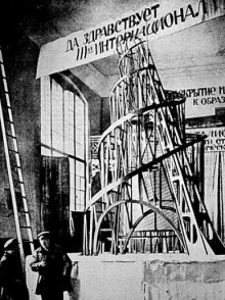[mks_dropcap style=”letter” size=”52″ bg_color=”#ffffff” txt_color=”#000000″]A[/mks_dropcap]t the beginning of the 20th century, the Tsarist rule of Imperial Russia oppressed and abused its subjects. However, the Sun was slowly setting on the old ways of the Russian Empire. Sociopolitically, workers and the ordinary folk followed Lenin towards a new order in 1917. Economically, industrialisation and technological advancements were understood within a framework of distribution of wealth among the people who created it. It was within this revolutionary context -too briefly put- that art drifted from what was understood as a fundamentally bourgeois expression into a reinvention of the Russian avant-garde. The idea was to reconstruct art.
The beginning
Sources differ on whether it was 1913 or 1914 when Russian Constructivism started, but it is referred to as Russian, and not Soviet, because it began before the 1917 Revolutions. In any case, Vladimir Tatlin (1885-1953) is universally regarded as the father of the movement and one of its foremost exponents.
An otherwise traditionally trained artist, Tatlin’s views were changed when he visited Paris in late 1913 and met Pablo Picasso, a fundamental event for the creation of the movement. Cubism’s unusually experimental constructions inspired his own work and, after returning to Russia, Tatlin explored and celebrated modern materials, technology and design along with other artists, leading to the first constructivist works from 1914 to 1920. His key contribution was the understanding that art ought not to be produced only for the sake of it. Instead, he envisioned it embedded in a social context that gave his works purpose beyond aesthetics.
Aside from the exploration of modernity, constructivists were aware of the sociopolitical context in which they lived. In this sense, the movement shared one key characteristic with the revolution -its criticism and refusal of the spiritual and divine.
Influence in the public sphere
The social aspect of Constructivism was manifested in a quote by the poet and artist Vladimir Mayakovsky (1893-1930), who proclaimed:
The streets shall be our brushes, the squares our palettes
Or perhaps, it was more evident in the general constructivist exclamation “Art for the people! Art into Life!”. In any case, the relation between the constructivists and the initial Bolshevik government was tight and clear. During the first days of the Soviet Union, Moscow became the artistic centre of the country, as constructivists and the Russian avant-garde undertook the task of redefining art and culture and its impact on the new society. Meaning, establishing a conscious relation between the Russian people and the objects of modernity through art and design. For example, one of the most visible innovations of the movement was its utilisation of industrial materials and its turn towards industrial design, in conjunction with an emphasis on proportion and rational design.
However, this new school did not only influence painters or sculptors, but also graphic designers, interior designers, architects and urban planners. The influx of constructivism is present throughout Soviet-era public constructions and it eventually worked its way into Soviet film and theatre, which often adopted an aesthetic bearing a resemblance to the works of Aleksandr Rodchencko (1891-1956; see ‘Books’ below) or the aforementioned Tatlin. Not only that, but this avant-garde current that had so tightly been connected to spreading revolutionary messages was adopted by the Soviet propaganda apparatus under a state-funded endorsement of the arts that aimed at the production of “extraordinary socialist objects”, objects of relevance for the construction of a collective Soviet identity. These sharp, largely allegorical objects and images were visual proof of the connection between the dynamism of modern life and the Communist society.

In fact, the image below, the monument known as Tatlin’s Tower, is the wooden model of Vladimir Tatlin’s projected 400-metre tall Monument to the Third International -supposedly the tallest of its kind at the time-, which was intended to host conferences and to provide a centre for propaganda-making during the World Congresses of the Communist Third International (1919-1943) in Moscow.

Even when most examples of constructivism used by the Soviet government are not as large and obvious as the tower, Soviet propaganda adopted five stylistic elements from constructionists: minimalist colour schemes, the use of abstraction and geometry, constructivist typography, abstract ambiguity in messages -later replaced by clear-cut Socialist Realism-, and the use revolutionary art designs known as “agitprop,” or agitation art.
Constructivism beyond Russia
Maybe this school of Russian art and architecture is relatively unknown for Western European audiences, but it had an influence on members of better known movements such as Bauhaus in Germany and De Stijl in the Netherlands. It also stuck with Latin American architects and artists like Enrique Tábara, Manuel Rendón and Joaquín Torres García.
So, why did it have such a varied, far-reaching impact? Maybe Russian constructivists reconciled art in its widest sense with society, imbuing their creations with a (revolutionary) meaning that represented the context they lived in. Similarly, in communication science, the study of human interaction and the social construction and exchange of meaning are fixtures in our professional practice, so there are always lessons to be learnt from applied approaches as this.
References:
Cargo Collective. (n.d.). Retrieved 2018, October 22 from http://cargocollective.com/biopower/THE-SOCIALIST-OBJECT
Tate Online. (n.d.). Retrieved 2018, October 22 from https://www.tate.org.uk/whats-on/tate-modern/exhibition/century-city/century-city-moscow-1916-30
The Art Story. (n.d.). Important Art by Aleksander Rodchenko [Blog Post]. Retrieved from https://www.theartstory.org/artist-rodchenko-alexander-artworks.htm
[Vladimir Tatlin and an assistant in front of the model for the Third International] [Photograph]. (1920). Retrieved from https://commons.wikimedia.org/wiki/File:Tatlin%27s_Tower_maket_1919_year.jpg
Pantelić, K. (2016). Russian Constructivism – The True Vanguard Movement. Widewalls. Retrieved from https://www.widewalls.ch/russian-constructivism/
Cover: self portrait by Aleksandr Rodchencko





